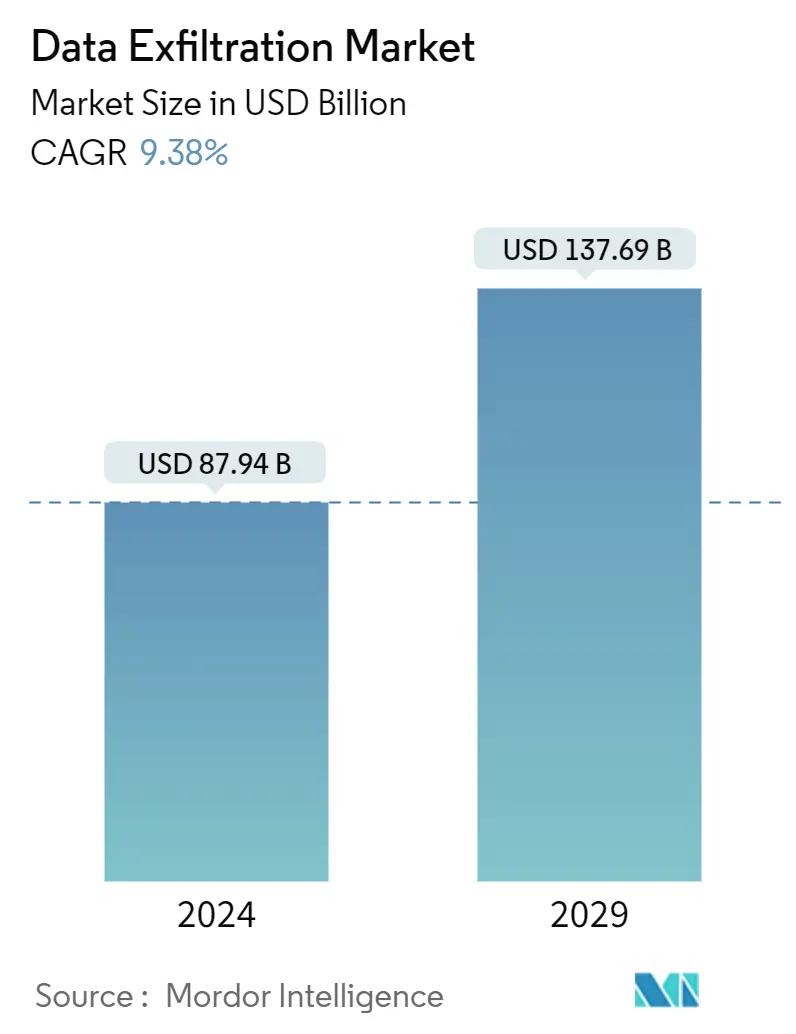Market Size of Data Exfiltration Industry

| Study Period | 2019 - 2029 |
| Market Size (2024) | USD 87.94 Billion |
| Market Size (2029) | USD 137.69 Billion |
| CAGR (2024 - 2029) | 9.38 % |
| Fastest Growing Market | Asia Pacific |
| Largest Market | North America |
Major Players
*Disclaimer: Major Players sorted in no particular order |
Need a report that reflects how COVID-19 has impacted this market and its growth?
Data Exfiltration Market Analysis
The Data Exfiltration Market size is estimated at USD 87.94 billion in 2024, and is expected to reach USD 137.69 billion by 2029, growing at a CAGR of 9.38% during the forecast period (2024-2029).
Data exfiltration is a security breach that occurs when sensitive information from an organization is transferred or copied without authorization from a server or a computer to a location controlled by a threat actor. It is primarily a targeted attack in which the hacker's primary goal is to copy and extract specific information from the data. Hackers directly access the targeted system via remote programs or by installing a portable media device. Personal health information, intellectual property or trade secrets of a firm, personally identifiable information, and financial information, such as credit card or bank details, are all large data breaches.
- The increasing volumes of enterprise data often contain valuable assets such as customer information, intellectual property, trade secrets, financial records, and other sensitive data. This makes organizations attractive targets for data exfiltration attacks. Protecting these valuable assets drives the demand for advanced prevention solutions.
- Strict regulatory requirements for data protection play a crucial role in driving the need for data exfiltration prevention. Various data protection regulations, such as the General Data Protection Regulation (GDPR), California Consumer Privacy Act (CCPA), and other regional or industry-specific regulations, mandate organizations to implement measures to protect sensitive data from unauthorized access, including data exfiltration. Compliance with these regulations is crucial to avoid legal penalties, reputational damage, and loss of customer trust.
- Increasing data loss incidents in the on-premises environment can drive the need for data exfiltration prevention. On-premises environments may have complex and interconnected IT systems, which can introduce vulnerabilities. Malicious actors can exploit these vulnerabilities to gain unauthorized access and exfiltrate sensitive data. The increasing data loss incidents in on-premises environments highlight the need for robust data exfiltration prevention solutions to protect against such threats.
- Compatibility issues between on-premises applications and the cloud environment can pose challenges and restrain the data exfiltration prevention market. Ensuring comprehensive data visibility and monitoring in a hybrid environment where on-premises applications interact with cloud services can be challenging. Data exfiltration prevention solutions often rely on monitoring network traffic, user behavior, and data access patterns to detect and prevent unauthorized data transfers. However, compatibility issues may hinder seamless monitoring across on-premises and cloud environments, limiting the effectiveness of data exfiltration prevention measures.
- The COVID-19 pandemic significantly impacted various aspects of the cybersecurity landscape, including the data exfiltration market. With the increased adoption of remote work during the pandemic, organizations rapidly adjusted their IT infrastructure and security measures. This sudden shift introduced new vulnerabilities and challenges, as remote work environments were expected to have different security controls than traditional on-premises setups. Attackers exploited these vulnerabilities to target remote workers and gain unauthorized access to sensitive data, increasing the risk of data exfiltration.
